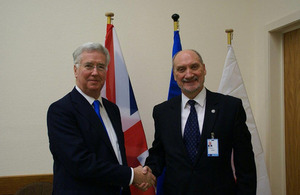UK to step up NATO maritime commitment
The UK will increase its maritime commitment to NATO exercises and activities, Defence Secretary Michael Fallon announced today.

Defence Secretary at the NATO Defence Ministerial in Brussels. Copyright: Polish Government.
At the NATO Defence Ministerial in Brussels the Defence Secretary outlined a maritime package that will see the UK almost double its deployments to NATO at sea in 2016.
For the first time since 2010 the UK will contribute to NATO’s Standing Maritime Group 1 (SNMG1), an enduring commitment to having NATO warships at sea, which will include two deployments planned this year:
-
the deployment of HMS Iron Duke, a Type 23 Frigate, from January to July, operating in the Baltic sea;
-
deployment of a Type 45 Destroyer to the SNMG1 from October to November.
The deployments, involving around 400 Royal Navy personnel, reflect the emphasis placed on NATO in last year’s Strategic Defence and Security Review.
Defence Secretary Michael Fallon said:
Increasing our NATO deployments sends a strong message to our enemies that we are ready to respond to any threat, and defend our allies.
2016 will see a particular focus on the Baltic region with our ships sent there as part of the Maritime Group, the Mine Counter Measure Group and the Baltops exercise.
The UK’s maritime commitment in 2016 will also see:
-
the provision of the NATO Response Force 2* Maritime Component Commander, Rear Admiral Alex Burton, who holds a key leadership role in the NATO Very High Readiness Joint Task Force maritime component throughout 2016.
-
the deployment of three Mine Sweepers – around 130 Navy personnel in total – to NATO’s Standing Naval Mine Counter Measure Group, each for four months. This programme will include covering the Baltic Sea, North Atlantic, North Sea and the Mediterranean Sea.
-
Agreement for NATO to use our National Exercise Joint Warrior in North Scotland and the North Atlantic in October of this year to train and certify the NATO Response Force maritime and air component commanders for their NRF commitments in 2017, involving upwards of 550 naval personnel.
-
The contribution of two Frigates to major anti-submarine warfare exercise Dynamic Mongoose, and the UK’s largest warship HMS Ocean to Exercise Baltops in the Baltic region.
-
The commitment of a Fleet Diving Unit to Exercise Open Spirit in Lithuania and Exercise Northern Challenge in Iceland.
The Defence Secretary also spoke about NATO’s deterrence stance in the face of Russian aggression, called on Allies to commit, ahead of the NATO Warsaw Summit in July, to meeting the NATO target to spend 2% of GDP on Defence within a decade, and updated on the UK’s role in the TACET initiative, which he announced in October.
Following Mr Fallon’s announcement of the UK’s role in TACET, the UK will be fully operational as part of TACET by the Warsaw summit, and this will be as a ‘Lead Nation’ for the initiative, alongside Germany and the US. The UK will take the lead on Airfield Operations; Infantry and Mechanised Infantry tactics; and aspects of Maritime Mine Counter-measures focusing on diving.